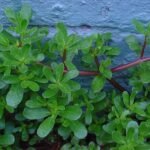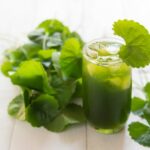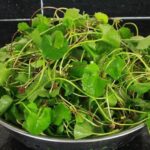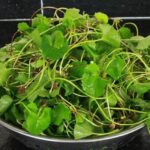1. Centella Asiatica
Centella Asiatica, also known as Asiatic pennywort or gotu kola, is a plant that belongs to the Apiaceae family. It is a wild-growing herb found throughout Vietnam.
The plant has a bitter and pungent taste and can be consumed fresh or dried. Vietnamese people consider it a cooling herb with neutral properties. It is believed to possess medicinal properties such as heat-clearing, detoxifying, anti-inflammatory, and blood-stopping effects. It is used to treat various ailments, including fever, boils, jaundice, hematemesis, nosebleeds, constipation, cough, and painful urination.
Centella Asiatica can be crushed to extract its juice or consumed in dried form as a tea. It can also be eaten raw and combined with another herb called “cỏ nhọ nồi” (translated as “black grass”) to promote hemostasis.
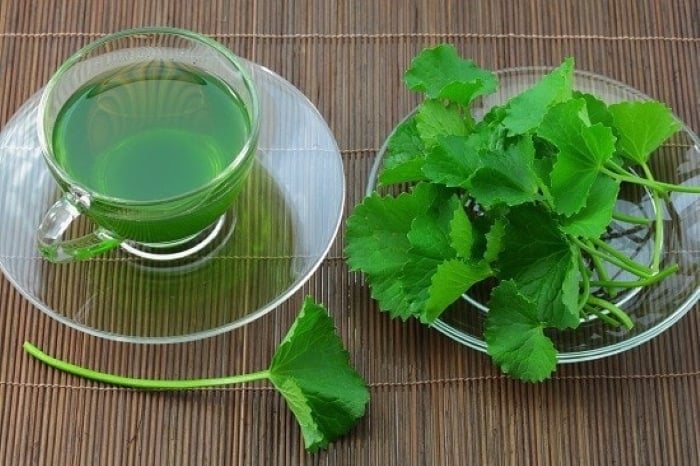
Centella Asiatica
2. Gardenia Fruit
Gardenia fruit, also known as gardenia jasminoides or cape jasmine, belongs to the Rubiaceae family. It is a shrub that typically grows to a height of 1-2 meters and remains green throughout the year. In mountainous regions, it often grows wild along streams.
Some families also cultivate gardenia as an ornamental plant and use its fruits for medicinal purposes and food coloring. During the autumn season, people harvest the ripe fruits and dry them in the sun to make traditional medicine.
In Vietnamese traditional medicine, gardenia fruit has been utilized for a long time to treat various conditions. It is believed to possess cooling properties, promote urination, purify the blood, and stop bleeding. It is used to address issues such as high fever, restlessness, insomnia, jaundice, difficult urination, hematuria, nosebleeds, bleeding due to heat, and swelling.
3. Vietnamese Wild Grape
Vietnamese wild grape, scientifically known as Cay Gai Leo, has several common names, including cay vanh, cay cuom, cay quanh, and cay quynh. It belongs to the Solanaceae family and grows wild throughout northern Vietnam and the province of Hue.
Locals typically dig up the roots, clean them, and dry them in the sun to prepare herbal remedies. Vietnamese wild grape is believed to possess medicinal properties such as dispelling wind and dampness, detoxifying, and relieving pain. It is used to treat bone and joint pain, cough, whooping cough, cirrhosis, and snake bites.
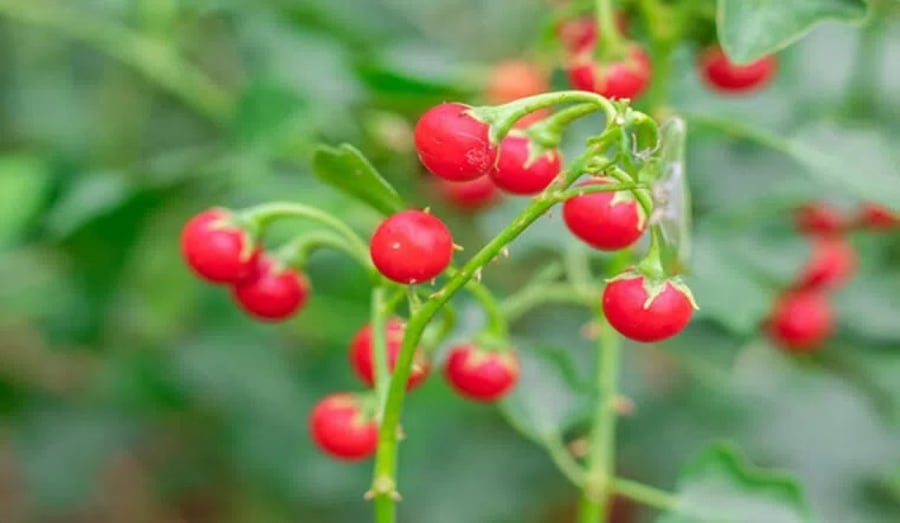
Vietnamese Wild Grape
4. Phyllanthus Niruri
Phyllanthus niruri, commonly known as stone breaker or seed-under-leaf, has various local names such as diếp hạ châu đắng, cây chó đẻ răng cưa, diệp hòe thái, and lão nha châu. It belongs to the Euphorbiaceae family.
This herb grows wild throughout Vietnam and other tropical regions. It is typically harvested year-round, with the summer season being the optimal time for collection. It can be used fresh or dried. Phyllanthus niruri is believed to possess medicinal properties such as detoxifying, sterilizing, promoting bile secretion, clearing the liver, anti-inflammatory, and dispersing stagnation. It is used to treat various ailments, including hepatitis, throat inflammation, mastitis, dysmenorrhea, nephritis, urinary calculi, boils, and skin itching.
The herb can be crushed and mixed with salt, or the fresh or dried plant can be decocted into a tea.
5. Black Alum
Black alum, also known as potash alum or phan diệp, belongs to the Euphorbiaceae family. It is a wild-growing shrub commonly found in Asian countries, including Vietnam.
Locals typically use the bark or fresh or dried leaves of the plant for medicinal purposes. The bark is dark brown on the outside and reddish-brown on the inside, with a bland and astringent taste. It is used to treat difficult urination. The dried leaves are made into pills and combined with a small amount of camphor and peppercorns to treat gum bleeding.
The leaves of black alum are also used to promote wound healing, while the young buds and leaves are used to treat diarrhea.
“Superfood in Your Garden: Discover the Ultimate Inexpensive Health Boost”
Wild vegetables, often dismissed as mere weeds and relegated to the compost heap, are nature’s hidden treasures. These unassuming plants, which freely grow in gardens, possess a dual benefit – they are a bounty of nutritional goodness and can be transformed into delicious, wholesome meals with ease.


























